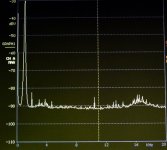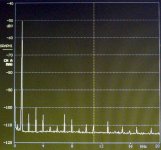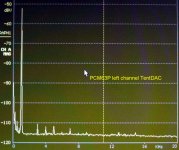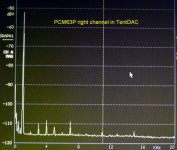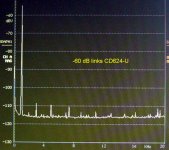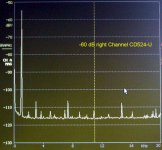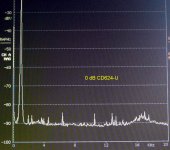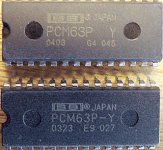The measurements above concerned the left channel. The picture here is of the right channel.
With a signal of 0 dB the graphs from the left and right channel are equal.
Be aware that the noise flour depends on the FFT Size (4096).
I am using the Hanning Window.
Any comments?
With a signal of 0 dB the graphs from the left and right channel are equal.
Be aware that the noise flour depends on the FFT Size (4096).
I am using the Hanning Window.
Any comments?
Attachments
PA0SU said:and here is the right channel........
Remember the 10 dB shift of the analyser!
The P's are at least 10 dB better than the P....K's !!!
With signals of 0 dB the P's are equal to the P....K's.
NO COMMENTS? Or is this tread dead?


In this picture -108 - -52 = -56 and other picture -58 which is normal, could be better, could be worse.
-50 for the K is bad.
Maybe swap chips between CD624 and tent and see what happens.
It would be good to see the swapped results. Aren't you are effectively testing the performance of the implementation by using the two convertors?
I might of missed it but can you give details of the test tones you are using? George and I are using files that have been dithered to 16 bits. I'm wondering if it might not be better to generate the test tones at 16 bit so the files don't require dithering?
Using lower FFT sizes with the RMAA software spectrum analyzer seemed to reduce the definition of the noise floor. I expect this is due to the larger slices of the audio spectrum being analyzed resulting in a degree of averaging?
The PCM63K (not PK) chips I checked had a higher noise floor with a more "jagged" appearance to the noise floor. Listening to these chips in one channel and the Y's in the other revealed that the K's sounded significantly more veiled.
I've only tested at -60dB so far but it appears that 0dB is required as well based on the discussions in the thread. Is there anything to be revealed by swept tones as opposed to a fixed test tone?
With any luck there should be some chips from A'af waiting at work, so I'll be able to test a larger sample of the Y's (once I pick up a couple of ZIF sockets later in the week!).
cheers
Paul
I might of missed it but can you give details of the test tones you are using? George and I are using files that have been dithered to 16 bits. I'm wondering if it might not be better to generate the test tones at 16 bit so the files don't require dithering?
Using lower FFT sizes with the RMAA software spectrum analyzer seemed to reduce the definition of the noise floor. I expect this is due to the larger slices of the audio spectrum being analyzed resulting in a degree of averaging?
The PCM63K (not PK) chips I checked had a higher noise floor with a more "jagged" appearance to the noise floor. Listening to these chips in one channel and the Y's in the other revealed that the K's sounded significantly more veiled.
I've only tested at -60dB so far but it appears that 0dB is required as well based on the discussions in the thread. Is there anything to be revealed by swept tones as opposed to a fixed test tone?
With any luck there should be some chips from A'af waiting at work, so I'll be able to test a larger sample of the Y's (once I pick up a couple of ZIF sockets later in the week!).
cheers
Paul
Paul,
It could well be that I'm testing the implementation of the two applications, however they are done on 'the same' PCB and 'the same' IV-convertor (see my web site). The difference is that the TentDAC is used via SPDIF and the implementation in the CD624-player scips the SPDIF. There is also a difference in the power supplies.......
The test tones are generated with Adobe Audition. One with 32 bits and the other with 16 bits, no dithering. The two signals give excactly the same results.....
I'm not an expert in this field, but I thought that the FFT-size corresponds with 'the length' of the FFT-filter which makes measurements slower and more precise, so I think you are right.
I think it is very difficult to listen to two mono signals to judge the quality of the DAC's. I never did a test like you. I THINK one could only judge DAC's with stereo-recordings.
The 0 dB-signal gives information about the distortion of signals between -6 dB and 0 dB, in other words the MSB distortion. BB talks about this distortion in the spec's. With the P's one could 'tune' for least distortion. With the K's this should not be nescessary..... Be aware that this distortion only becomes important with amplitude compressed (pop) music normalized to 0 dB !!! With neat recordings this is of much less importance.
Using swept tones is useless with our type of spectrum analysers because it takes some time to avarage the results. With a swepped tone one will find a little bit higher noise flour WITHOUT any distortion peaks. They will be avaraged as well !!!
I measured with different fixed frequencies but found no differences so I went back to the 991 Hz to avoid discussions....
I am just waiting for some Y samples from A'af. The way from Indonisia to the Netherlands seems to be rather long.....
It could well be that I'm testing the implementation of the two applications, however they are done on 'the same' PCB and 'the same' IV-convertor (see my web site). The difference is that the TentDAC is used via SPDIF and the implementation in the CD624-player scips the SPDIF. There is also a difference in the power supplies.......
The test tones are generated with Adobe Audition. One with 32 bits and the other with 16 bits, no dithering. The two signals give excactly the same results.....
I'm not an expert in this field, but I thought that the FFT-size corresponds with 'the length' of the FFT-filter which makes measurements slower and more precise, so I think you are right.
I think it is very difficult to listen to two mono signals to judge the quality of the DAC's. I never did a test like you. I THINK one could only judge DAC's with stereo-recordings.
The 0 dB-signal gives information about the distortion of signals between -6 dB and 0 dB, in other words the MSB distortion. BB talks about this distortion in the spec's. With the P's one could 'tune' for least distortion. With the K's this should not be nescessary..... Be aware that this distortion only becomes important with amplitude compressed (pop) music normalized to 0 dB !!! With neat recordings this is of much less importance.
Using swept tones is useless with our type of spectrum analysers because it takes some time to avarage the results. With a swepped tone one will find a little bit higher noise flour WITHOUT any distortion peaks. They will be avaraged as well !!!
I measured with different fixed frequencies but found no differences so I went back to the 991 Hz to avoid discussions....
I am just waiting for some Y samples from A'af. The way from Indonisia to the Netherlands seems to be rather long.....
I wasn't aware the DAC's were essentially the same. Thanks for pointing that out.
The reason I tried testing the different chips per channel was more of an experiment to see if the chips selected purely on the basis of low harmonic distortion were a good match despite different markings. This wasn't the case. So it seems in this case that the differences in the level of noise floor are far more apparent than differences in harmonic distortion. I'm sure with more closely matched noise floors HD would become more significant.
I'm rely on software for analysis, which is a mixed blessing. While I'm sure this method isn't nearly as accurate as using a hardware analyser, it does allow the data to visualised in different ways. I'll give the swept tone a try and see if sonogram display shows up anything interesting.
cheers
Paul
The reason I tried testing the different chips per channel was more of an experiment to see if the chips selected purely on the basis of low harmonic distortion were a good match despite different markings. This wasn't the case. So it seems in this case that the differences in the level of noise floor are far more apparent than differences in harmonic distortion. I'm sure with more closely matched noise floors HD would become more significant.
I'm rely on software for analysis, which is a mixed blessing. While I'm sure this method isn't nearly as accurate as using a hardware analyser, it does allow the data to visualised in different ways. I'll give the swept tone a try and see if sonogram display shows up anything interesting.
cheers
Paul
and the 0 dB measurement has been attatched here, but
WHAT (KIND OF) PLAYER IS THIS ????
Yes, it is a Philips CD624, BUT:
UNmodified. again: UN-MO-DI-FIED !!! with the SAA7320 as digital filter + DAC + IV-converter which sounds so poor that I use it to demonstrate the influence of a low-jitter-clock, reclocking of the digital signals just before the DAC (a PCM63P in my case) and a correct lay out of the PCB. These three subjects have been dissolved in the TentLabs-DAC.
My conclusion again is that the low signal distorsion far below the noise level of a recording (a concert hall has a noise flour of about -60 dB) is ABSOLUTELY not important!

I do not say that there is no difference between the sound of different DAC's of the same type, but it has NOTHING to do with the low level distortion you all are looking after.

The measured figures of this unmodified CD624 are better or at least equal to those of my PCM63P's end/or PCM63P..K's in the TantLabs-DAC-construction, but the sound from it is UNCOMPARIBLE WORSE !

WHAT (KIND OF) PLAYER IS THIS ????
Yes, it is a Philips CD624, BUT:
UNmodified. again: UN-MO-DI-FIED !!! with the SAA7320 as digital filter + DAC + IV-converter which sounds so poor that I use it to demonstrate the influence of a low-jitter-clock, reclocking of the digital signals just before the DAC (a PCM63P in my case) and a correct lay out of the PCB. These three subjects have been dissolved in the TentLabs-DAC.
My conclusion again is that the low signal distorsion far below the noise level of a recording (a concert hall has a noise flour of about -60 dB) is ABSOLUTELY not important!


I do not say that there is no difference between the sound of different DAC's of the same type, but it has NOTHING to do with the low level distortion you all are looking after.
The measured figures of this unmodified CD624 are better or at least equal to those of my PCM63P's end/or PCM63P..K's in the TantLabs-DAC-construction, but the sound from it is UNCOMPARIBLE WORSE !


Attachments
PA0SU said:and the 0 dB measurement has been attatched here, but WHAT (KIND OF) PLAYER IS THIS ???? Yes, it is a Philips CD624, BUT: UNmodified. again: UN-MO-DI-FIED !!!
with the SAA7320 as digital filter + DAC + IV-converter which sounds so poor that I use it to demonstrate the influence of a low-jitter-clock, reclocking of the digital signals just before the DAC (a PCM63P in my case) and a correct lay out of the PCB. These three subjects have been dissolved in the TentLabs-DAC.
Pardon Herb, but to whom are you doing your demonstrations with this device? To terribly hard of hearing people?? I am not sure if even they needs such a quite horrible demonstrating to understand what are the sound differences & advantageous of using a clock, etc... AND with this one certainly does not implement the Tent DAC in the right surround… or may be ???
My conclusion again is that the low signal distorsion far below the noise level of a recording (a concert hall has a noise flour of about -60 dB) is ABSOLUTELY not important!
.
I do not say that there is no difference between the sound of different DAC's of the same type, but it has NOTHING to do with the low level distortion you all are looking after.
.
You are mixing too different things!! A -60 db of a noise level in the hall (true!) has NOTHING to do with our perception during the listening process!!
AND with the above mentioned "device" I would be very careful wenn coming to conclusions about the true influance of the low level distortion on listening.
The measured figures of this unmodified CD624 are better or at least equal to those of my PCM63P's end/or PCM63P..K's in the TantLabs-DAC-construction, but the sound from it is UNCOMPARIBLE WORSE !

At least this!!
Hi PA0SU,
Your tests don't seem to back up your claims.
The noise floor on the -60dB links CD624-U is clearly less smooth that the one you show for the tent dac. I'm contending that the spikes visible in the noise floor are just as important as the peaks of harmonic distortion.
Referring to your graphs the noise floor in the tent-labs dac drops as frequency increases and is relatively smooth. The CD624 displays numerous spikes, and a rising noise floor. I'd say there is more than ample difference visible in your posts to suggest the DACs will perform differently.
I've reread the Audio Precision app note AN-5 - "Measurement Techniques for Digital Audio" and the author recommends using dithered test signals to get best detail from low level signals. I'll stick with my current test tones for the moment.
Also take a look at http://www.digido.com/bob-katz/dither.html Part II is most relevant.
Bob Katz claims that sounds down to -115dB are audible on a well dithered CD. That's just a little lower level than -60dB.
cheers
Paul
Your tests don't seem to back up your claims.
The noise floor on the -60dB links CD624-U is clearly less smooth that the one you show for the tent dac. I'm contending that the spikes visible in the noise floor are just as important as the peaks of harmonic distortion.
Referring to your graphs the noise floor in the tent-labs dac drops as frequency increases and is relatively smooth. The CD624 displays numerous spikes, and a rising noise floor. I'd say there is more than ample difference visible in your posts to suggest the DACs will perform differently.
I've reread the Audio Precision app note AN-5 - "Measurement Techniques for Digital Audio" and the author recommends using dithered test signals to get best detail from low level signals. I'll stick with my current test tones for the moment.
Also take a look at http://www.digido.com/bob-katz/dither.html Part II is most relevant.
Bob Katz claims that sounds down to -115dB are audible on a well dithered CD. That's just a little lower level than -60dB.
cheers
Paul
Gentlemen,
it seems that I have to learn! At the very moment I have to do other things, but will be back with new knowledge, measurements and listening reports from a VERY EXPERIANCED panel.
By the way, my further experiments can go on. I just received a number of PCM63P (-) Y's from our friend A'af......
it seems that I have to learn! At the very moment I have to do other things, but will be back with new knowledge, measurements and listening reports from a VERY EXPERIANCED panel.
By the way, my further experiments can go on. I just received a number of PCM63P (-) Y's from our friend A'af......
Attachments
Paul,
I have read the document in question..... down to -115 dB!
My living room has the lucky noise flour of 30 to 40 dB, and this is very quit for a normal house.
When I'm playing music on a peak-level of 100 dB, which is rather loud (then I'm surrounded by the noise floor of the concert hall), then I should notice sounds 45 dB under the noise flour of my room?
Spencer,
Swapping DAC chips (after measuring of course) is prcisely what I am going to do with my panel.
I have read the document in question..... down to -115 dB!
My living room has the lucky noise flour of 30 to 40 dB, and this is very quit for a normal house.
When I'm playing music on a peak-level of 100 dB, which is rather loud (then I'm surrounded by the noise floor of the concert hall), then I should notice sounds 45 dB under the noise flour of my room?

Spencer,
Swapping DAC chips (after measuring of course) is prcisely what I am going to do with my panel.
Hi PA0SU,
The noise floor of the listening or recording environment is really a separate issue from DAC distortion. The distortion in the dac alters the reproduced signal regardless.
I think also there is some confusion on dB. We seem to be mixing and matching two different kinds of measurement as if they were one and the same. Average sound levels in a room are measured as sound pressure levels - db SPL. In digital recording and reproduction the levels are measured against the loudest signal that can be represented digitally 0 dB FS (full scale). So -60dbFS is 60db below full scale on the recorded medium. To have any idea of how sound levels in a room are related to the signal on the recorded medium you have to take into account what level of gain of is applied to the signal. If you are listening to a quite piece of music recorded in a well designed recording studio with an average level of -60db FS that doesn't mean the level of reproduced sound will be 60dB SPL. It entirely depends on the level of gain/volume you set on your hifi. If you decide to set the volume so the average level of -60dBFS is reproduced at 80dB SPL your room noise floor will start to obscure detail in the recording below -100 or -110dB FS. Under these circumstances the limits of CD reproduction would be only 5 to 15dB below the average sound level of your room.
Second thing is that the noise "floor" isn't a solid barrier It is the average level of ambient sound. I can hear birds singing and dogs barking in the distance as I type and they are substantially quieter than a passing car for example. So it's wrong to think that the level of noise in your listening room (or a concert hall for that matter) acts as a "brick wall" filter for detail. It just makes the detail in a recording progressively more difficult to perceive as the playback level drops below the average noise level of the room.
It is the average level of ambient sound. I can hear birds singing and dogs barking in the distance as I type and they are substantially quieter than a passing car for example. So it's wrong to think that the level of noise in your listening room (or a concert hall for that matter) acts as a "brick wall" filter for detail. It just makes the detail in a recording progressively more difficult to perceive as the playback level drops below the average noise level of the room.
cheers
Paul
The noise floor of the listening or recording environment is really a separate issue from DAC distortion. The distortion in the dac alters the reproduced signal regardless.
I think also there is some confusion on dB. We seem to be mixing and matching two different kinds of measurement as if they were one and the same. Average sound levels in a room are measured as sound pressure levels - db SPL. In digital recording and reproduction the levels are measured against the loudest signal that can be represented digitally 0 dB FS (full scale). So -60dbFS is 60db below full scale on the recorded medium. To have any idea of how sound levels in a room are related to the signal on the recorded medium you have to take into account what level of gain of is applied to the signal. If you are listening to a quite piece of music recorded in a well designed recording studio with an average level of -60db FS that doesn't mean the level of reproduced sound will be 60dB SPL. It entirely depends on the level of gain/volume you set on your hifi. If you decide to set the volume so the average level of -60dBFS is reproduced at 80dB SPL your room noise floor will start to obscure detail in the recording below -100 or -110dB FS. Under these circumstances the limits of CD reproduction would be only 5 to 15dB below the average sound level of your room.
Second thing is that the noise "floor" isn't a solid barrier
cheers
Paul
Found this explaination of why AP choose to use a 997hz test tone:
http://www.hit.bme.hu/~papay/edu/Acrobat/Fund.pdf
Finger (1986) has shown that proper signal generation in digital systems requires that the generated frequencies be relatively prime to the sample rate. If frequencies are used which are submultiples of the sample rate, the waveform will exercise only a few codes of the digital word. For example, generating 1 kHz in a 48 kHz sample rate system will require only 48 different data values. This may leave large portions of a converter untested. If frequencies are used which are prime to the sample rate then eventually every code in the data word will be used. Using 997 Hz instead of 1 kHz will result in all codes of a digital system (operating at standard sample rates) being exercised. This frequency makes a good “digital 1 kHz” since it is also prime to the 44.1 kHz consumer standard sampling frequency.
http://www.hit.bme.hu/~papay/edu/Acrobat/Fund.pdf
Thanks Paul for all info.
I will read it carefully, but.....
what do I want more than immediate recognition of the concert hall where I made a recording.... I always take a short recording when the hall is nearly empty, only with some personel who talks quitely to each other or move a chair on the stage....
The recognition is because of the akkoustics close to the noise floor.... Yes I understand very well the difference between 'background noise in a room' and 'electronical noise' but sometimes it seems so theoratical to me when the differences in level are so large. In all publications (dither and so on) there should be a great advantage applying their solution. For me it sounds terrific after using a very low noise clock, reclocking of the signals before the DAC, using a good IV-convertor on a PCB with the right lay out. I still think that these subjects are the most important.
However, I want still learn things of you and others!
I will read it carefully, but.....
what do I want more than immediate recognition of the concert hall where I made a recording.... I always take a short recording when the hall is nearly empty, only with some personel who talks quitely to each other or move a chair on the stage....
The recognition is because of the akkoustics close to the noise floor.... Yes I understand very well the difference between 'background noise in a room' and 'electronical noise' but sometimes it seems so theoratical to me when the differences in level are so large. In all publications (dither and so on) there should be a great advantage applying their solution. For me it sounds terrific after using a very low noise clock, reclocking of the signals before the DAC, using a good IV-convertor on a PCB with the right lay out. I still think that these subjects are the most important.
However, I want still learn things of you and others!
- Status
- This old topic is closed. If you want to reopen this topic, contact a moderator using the "Report Post" button.
- Home
- Source & Line
- Digital Line Level
- Real or fake PCM63?
